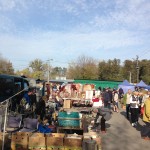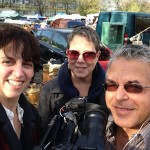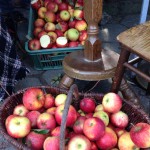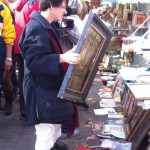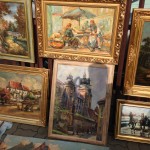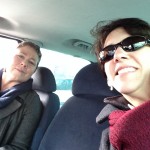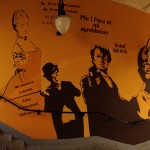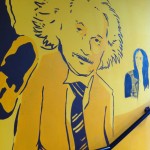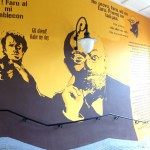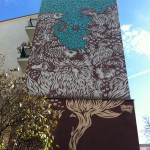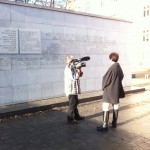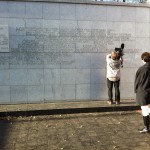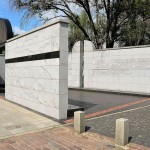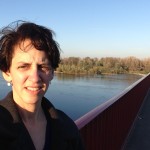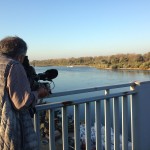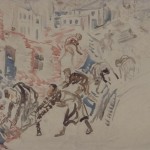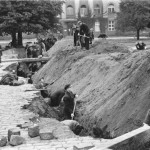Sunday morning we trekked off to Koło Bazaar. I had been told that Jewish ephemera often appears in this Sunday market and I wanted to see if I might find a Moshe Rynecki painting. I never thought I would find an original piece at the market, but I was optimistic that I might find a replica or a fake piece. (Yes, there seems to be growing interest in my great grandfather’s art and we are now aware that replicas and fake pieces do exist.) The market is a sprawling street fair/flea market selling everything from fur hats and traditional Polish costume to silver ware and dinner plates and, of course, art. There’s a lot of art, but none of it very impressive. I spoke to a man whose friend was selling paintings at the edge of the market and asked him if he knew the work of Moshe Rynecki. He told me “everything here is bullshit.”
Here are a few photos of the morning at the fair. The selfie-photo is myself, and my Warsaw film production team Catherine Greenblatt (a long time friend and an important part of the film production team! Read Cathy’s POV included in this blog post below), and Slawomir Grunberg (my cameraman, guide, interpreter, advisor, and so much more!). It’s important to eat apples in Poland these days [Russia band their import for “sanitary reasons,” so eating apples has become a rallying cry of support for Polish farmers and Poland, in general. In the photos along the bottom row I’m closely examining some pictures I’ve found. The painting I’m holding is some sort of Jewish image, but it’s clearly not a Rynecki piece. The question is whether it’s even an authentic piece of Judaica….doubtful.
We left the market by cab to go and grab lunch in another part of town. After lunch we took a walk toward our next destination and happened upon these intriguing murals. The yellow wall includes many famous people, Hollywood actors, and intellectuals. The man with glasses who looks like the lampfixture is coming out of his head is Zamenhof, the inventor of Esperanto (yes, he’s Polish and Jewish). Other folks pictured here include Dirty Harry (Clint Eastwood) saying “go ahead, make my day”, Donkey from Shrek, and Yoda. It’s really quite a collection of figures!
Our next destination was Krasinskich (Krasinski) park, but first we made a brief stop at Więźniów Politycznych Stalinizmu (loose translation: A Square remembering Stalin’s Political Prisoners) because who doesn’t enjoy a chance to pound out “chopsticks” on an abandoned piano?! Across the street, near the entrance to Krasinski Park is another Warsaw Ghetto Monument. Park of the ghetto wall ran through the park during the war. Today the park is a lovely place. Families were strolling with young children, couples were enjoying the view of the lake, and I sat down to admire the fall leaves. I’d come to Krasinski park searching for the six old men of my great-grandfather’s paintings. I didn’t see anything like them, but I found benches beneath the lovely trees and amidst the folliage. As I took it all in, I felt like I had a glimpse through time of why Moshe’s painted here – such a calm and beautiful spot in the center of the busy city.
Next up was a visit to the Umschlagplatz Memorial. You can read the post of my experience there in a separate blog, “A Negative Encounter at the Umschlagplatz Memorial.” The first two photos here show Slawomir filming me at the memorial. The photo of the memorial site itself is not my photograph. It is from the Wikipedia page about the memorial – link provided.
- photo from: http://bit.ly/1t1pBIn
The last site of the day was a trip to a bridge grandpa George writes about in his memoir:
“After a day or two, I decided to move to Warsaw. I was stranded and desperate. I could depend on my parents. They still had the large apartment on Krucza. The railroad was out, the car was gone, and the only way to get there was to walk. Along the rails in sandy ground. We started one morning to walk. It was tedious. Sand and more sand. Alex got very quickly tired and I had to take him on my shoulders with a couple packs in my hands. Hotter than hell in this early September 1939. The battlefield losses of the Poles, the rapid progress of German armies, all this was no incentive to live, or act intelligently. A few miles, but how difficult. When we reached the Vistula and the Kierbedzia bridge, I was exhausted. And there, right on the bridge, the Polish soldiers were building a barricade of sorts to protect the approach from the east. As I was thinking, an officer stopped me, requesting my help in building the barricades.”
The bridge was bombed out in the war and rebuilt with a new name: Śląsko-Dąbrowski Bridge. Across the Vistula River is the Warsaw Zoo (if you haven’t already done so, read Diane Ackerman’s The Zookeeper’s Wife). I took a walk on the bridge, stared at the sandy banks, and thought about the Moshe Rynecki painting that shows men who helped to build a barricade of sorts, to protect the approach from the east. The source of this black and white photo of the men digging the sort of barricade my grandpa George helped build and that Moshe Rynecki painted, is from the US Holocaust Memorial Museum online exhibition: http://bit.ly/Z4zklz
- Forced Labor. 1939.
Cathy’s POV: When Elizabeth and I started to talk about this documentary project many years ago, we knew that the story would not unfold simply. Yes, it would involve work, research, persistence, and chasing ghosts as well as portraits. Not every effort would reveal a lost painting or a fragment of Moshe’s life or new information. Dead ends are a part of the narrative, even though they may not illuminate Moshe’s story. But when we opened our eyes to the possibilities inherent in lost leads and dead ends, curious tangents began to offer another set of possibilities for telling the story. Looking for fakes and reproductions has become an interesting development in our research, and they throw a fascinating wrench into telling the story. Why is Moshe’s work being forged, faked, copied, or reproduced? Is it Moshe’s fame as an artist? Not likely. More probable is the current fascination with Judaica in Poland, which seems strange to a North American sensibility.
